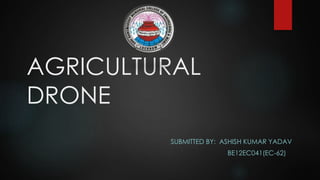
agriculturaldrone-150817190548-lva1-app6891.pdf
- 1. AGRICULTURAL DRONE SUBMITTED BY: ASHISH KUMAR YADAV BE12EC041(EC-62)
- 2. INTRODUCTION Drones are formally known as unmanned aerial vehicle which is essentially a flying robot. It can be controlled by either pilot from the ground or it can be autonomous. The drones which are used for agriculture purpose are called as agriculture drone. In current scenario it is also being used for surveillance, traffic monitoring, weather monitoring.
- 4. VISUAL SENSOR It is used for aerial mapping and imaging Photogrammetry and 3D reconstruction Plant counting Surveillance Emergency response Surveying and Land use application
- 5. MULTISPECTRAL SENSOR They range in numbers of bands and resolution topping out under 1 cm per pixel. Multispectral Sensors are widely used in: Plant health measurement Water quality assessment Vegetation index Plant counting
- 6. THERMAL SENSOR Thermal sensors are best utilized in: Heat signature detection Livestock detection Surveillance and security Water temperature detection and water source detection Emergency response
- 7. LIDAR SENSOR Short range, 270º scanning LASER rangefinder Useful in 3D digital surface modelling stockpile calculation Surface variation detection and flood mapping Penetrates through vegetation: It can perform plant height measurement by collecting range information from the plant canopy and the ground below (as opposed to the passive optical imagers that provide height data from the canopy)
- 8. HYPERSPECTRAL SENSOR Hyper spectral sensors are widely used in: Plant health measurement Water quality assessment Vegetation index calculation Full spectral sensing Spectral research and development Mineral and surface composition surveys
- 9. HOW DRONES CAN BE USED IN AGRICULTURE Chemical applications Land & building management Crop & livestock inventory management Crop monitoring(nutrient, water, pest)
- 10. PLANTS SHOW DAMAGE IN INFRARED AND NEAR-INFRARED (Chlorophyll absorbs infrared light. Damaged plants have less chlorophyll)
- 12. False color image NDVI Image (dark soil vs. regular soil. The dark green shows higher biomass and healthier crop Visually, this variety in particular seems to be doing better than others on the dark soil
- 13. BUG MAPPING Bug Mapping of Spider Mite Population in Peanut
- 14. INVENTORY MANAGEMENT IN OPEN FIELD NURSERIES
- 16. PLANT COUNTING
- 18. BIG DATA AGRICULTURE Half of farm inputs are wasted due to lost information(the “open loop” problem) x 0.5x • Opportunity: "Closed-loop farming". Use aerial data capture to use chemicals/water/labor only where they’re needed.
- 19. Precision (Site-Specific) Agriculture Yield monitoring and mapping Soil condition mapping (variable rate fertilizer) Weed mapping
- 20. CHALLENGES- SYSTEM ISSUES Extend battery life (stay aloft for 5-15 minutes - limited ground coverage) Variety of UAV types (semi-autonomous, hand launched etc.) Research data on reliability is missing (500 hrs, 1000 hrs etc. useful life) Weather robust Missing data network to download images and videos from multiple UAVs Minimize solar flare impact on navigation Safety issues
- 22. Why Farming? Why Now?
- 23. Drones
- 24. BENEFITS Highest Economic Benefit Spot disease/problems faster Use less chemicals and water (save money, better for food and environment) Improve productivity